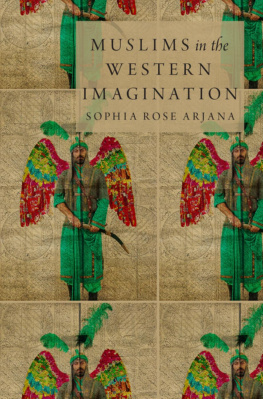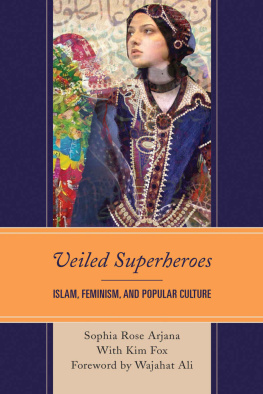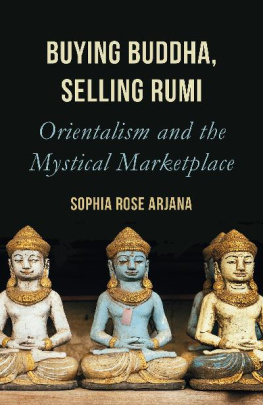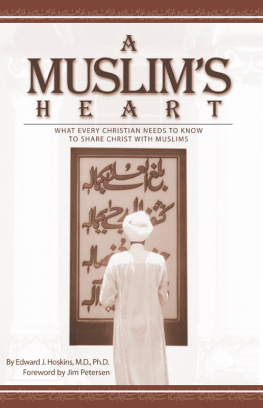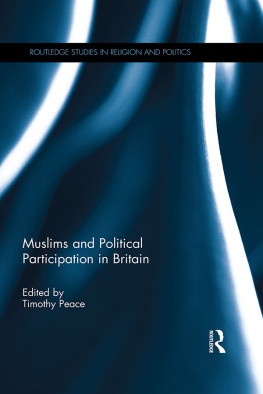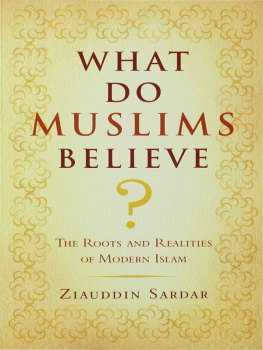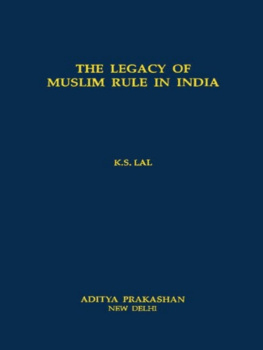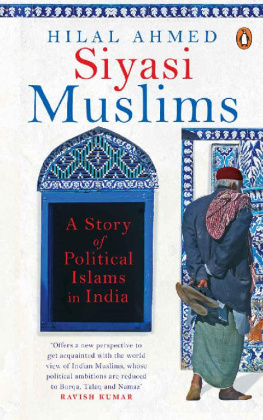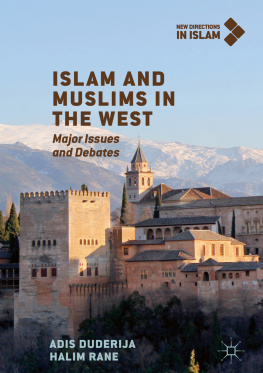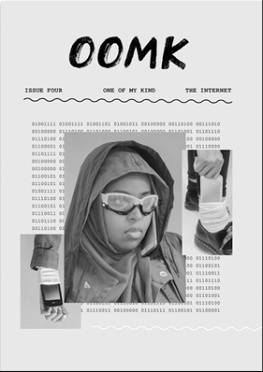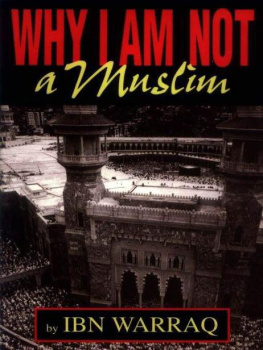Muslims in the Western Imagination
Muslims in the Western Imagination
z
SOPHIA ROSE ARJANA
Oxford University Press is a department of the University of
Oxford. It furthers the Universitys objective of excellence in research,
scholarship, and education by publishing worldwide.
Oxford New York
Auckland Cape Town Dar es Salaam Hong Kong Karachi
Kuala Lumpur Madrid Melbourne Mexico City Nairobi
New Delhi Shanghai Taipei Toronto
With offices in
Argentina Austria Brazil Chile Czech Republic France Greece
Guatemala Hungary Italy Japan Poland Portugal Singapore
South Korea Switzerland Thailand Turkey Ukraine Vietnam
Oxford is a registered trademark of Oxford University Press
in the UK and certain other countries.
Published in the United States of America by
Oxford University Press
198 Madison Avenue, New York, NY 10016
Oxford University Press 2015
All rights reserved. No part of this publication may be reproduced, stored in a
retrieval system, or transmitted, in any form or by any means, without the prior
permission in writing of Oxford University Press, or as expressly permitted by law,
by license, or under terms agreed with the appropriate reproduction rights organization.
Inquiries concerning reproduction outside the scope of the above should be sent to the
Rights Department, Oxford University Press, at the address above.
You must not circulate this work in any other form
and you must impose this same condition on any acquirer.
Library of Congress Cataloging-in-Publication Data
Arjana, Sophia Rose.
Muslims in the Western imagination / Sophia Rose Arjana.
pages cm
Includes bibliographical references and index.
ISBN 9780199324927 (hardcover : alk. paper)ISBN 9780199324934 (ebook)
ISBN 9780199324941 (ebook) 1. Islamophobia. 2. East and West. 3. Muslims
Public opinion. I. Title. BP52.S43 2015
305.697091821dc23
2014011529
1 3 5 7 9 8 6 4 2
Printed in the United States of America
on acid-free paper
For Trayvon Martin and all victims of an imagination run riot.
We should never reduce the Other to our enemy, to the
bearer of false knowledge, and so forth: always within him
or her there is the Absolute of the impenetrable abyss of
another person.
Sl avoj ZiZek
Somehow we must be able to share each others past in
order to be knowingly in each others present.
johanneS Fabian
Contents
Six yearS ago I was formulating a dissertation topic focused on the dehumanization of Muslim men. With the help of several individuals, including Mark George, Pamela Eisenbaum, and Frank Seeburger, I settled on the subject of Muslim monsters. Through many conversations and edits, two complete rewrites of a large corpus of research, and many late nights, I have had the support of many colleagues, fellow scholars, students, friends, and family, all of whom I would like to thank here.
Books are a collaborative effort. Oxford University Press has provided support, feedback, and criticism at crucial stages in this project, for which I am grateful. My friend and editor Jean Charney deserves thanks for her countless pages of edits, notes, and suggestions. Friends and colleagues, in particular Julie Todd, Kelly Arora, R.J. Hernandez-Diaz, and Aaron Conley also gave me valuable feedback. My students, especially the cohort that graduated from Iliff School of Theology in 2014, offered endless encouragement, a gift for which I am thankful. The most important of these academic voices, however, is my colleague Jacob Kinnard, who deserves abundant credit and thanks for his patient reading, meticulous comments, and unwavering support on this project in its early stages. Finally, my husband and best friend, Bayu Arjana, has been a source of encouragement in the last stages of this book, showing kindness and grace through many months and countless hours of research, writing, and editing. To him and our children I am forever grateful.
Sophia R. Arjana
Iliff School of Theology
Muslims in the Western Imagination
Islam in the Western Imagination
ThiS book aSkS the critical question, how did we get here, to this place of hijab bans and outlawed minarets, secret renditions of enemy combatants, Abu Ghraib, and GTMO? It is not simply a result of September 11, 2001, Madrid 2004, or London 2005, nor a culmination of events of the past decade or the past century. Terrorist attacks, wars in Iraq and Afghanistan, the increased movement of Muslim immigrants into northern and western Europe, and the visibility of Islam in general have contributed to a voicing of the Muslim problem. However, these concerns represent old anxieties that lie within a multiplicity of times and spaces on the pages of manuscripts and canvases of paintings, in works of great drama, poetry, and fiction, within travel diaries and government documents, and on the screens of movie theaters. To find the answer to the question posed here, we must look at numerous fields of cultural production; there, we find a vision of Islam that is both familiar and unsettling. Within it, we must seek what is common. What is common is the Muslim monster.
The history of monsters is a subject addressed in several disciplines, among them history, theology, and religious studies. In this study, I will argue that imaginary Muslim monsters have determined the construction of the Muslim in Western thought. At times, these constructions have involved fantasies about Jewish and African bodies; at other times, they have reacted to anxieties surrounding categories beyond racein particular, those related to religion, gender, and sexuality. To be clear, I am interested here in raising an awareness of these creaturesdemons, giants, cannibals, vampires, zombies, and other monstersthat can help us understand the status of Muslims today as stock characters in the Western imaginary landscape. The character of the homicidal terroristic Muslim stalks the Western social imaginary in print media, television, and film, but he has ancestors.
Muslim men are so dehumanized that since 9/11 they have become less than zero, an example of Agambens bare life, reduced to bodies held indefinitely, stripped of all legal rights afforded under US domestic and international law, force-fed like animals.1 The stripping of identity, displays of sadomasochism and other sexual fantasies, and the manipulation of multiple bodies through hooding and piles of naked bodies are examples of biopower (the technology of power that manages human bodies). These acts recall terrible visions embedded in our collective historical memory, including genocidal mass executions and graves.2 Such crimes are not explained simply by the culture of the military industrial establishment. They are also an effect of fantasies about Muslims as non-human
fantasies that have spanned the ages.
An imperative point regarding the vocabulary used in this study is that the history of Muslim monsters is distinguished from what we think of as Islamophobia, the particularistic attitude toward Muslims that scholars have often described as an aversion to or anxiety of Islam.3 Much of the scholarship has argued that contemporary Islamophobia is situated in political neoliberalism and the vision of the world it wishes to create, seen perhaps most vividly in the political discourse surrounding the attacks of September 11, 2001, and the War on Terror, which highlighted the Good Muslim/Bad Muslim trope by suggesting that any opposition to American militarism was tantamount to supporting the enemy.4 I am concerned here with the Wests imaginaire of Islam: the idea of the Muslim as a frightening adversary, an outside enemy that doesnt belong in modernity, who, due to an intrinsic alterity, must be excluded from the American and European landscapes.
Next page
